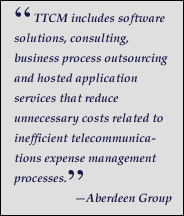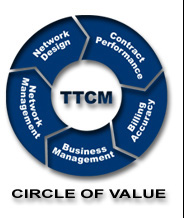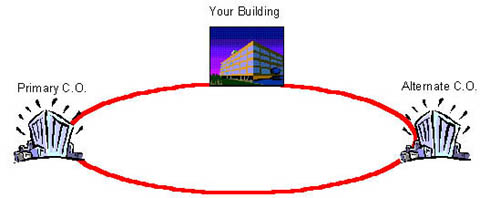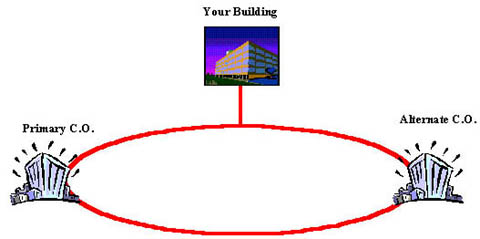




TTCM Savings Area:
Network Performance
Published In: Volume
3 Issue 6
Date: November,
2004
|
Today, voice and data communications are more essential to productivity than any other building service, with fiber emerging as a solution of choice for delivering mission critical communication services. Replacing copper loops with fiber is a good first step, so long as the basic points of failure are properly identified and resolved.
Although fiber is superior to copper in many ways, you must mitigate vulnerabilities in the following areas to minimize your potential for downtime.
I'm sure you've heard of Backhoe Fade, whereby a high technology fiber line is rendered useless by a low technology piece of diesel machinery. The only way to protect against the inevitable trenching incident (per Murphy's Law) is to receive your fiber over a ring offering full redundancy. To meet this requirement, the provider must have two separate fiber cables penetrating your building at different points, and routed to their equipment with a minimum of 25 feet of space separation within your building. Ideally, each cable will first terminate at different COs, before looping back to the CO the other cable terminated at. Figure 1 depicts a fully redundant ring topology, offering you the most protection in the event of a failure.
Figure 1 - Fully Redundant Loop Many times a provider will connect your building to a "nearby" ring via a single fiber cable. This type of connectivity is generally referred to as spur topology and is illustrated in Figure 2. As you can see, a failure in the fiber between the ring and the provider's equipment in your building will result in a total outage. The further the distance from the actual ring, the more susceptible you are to loss of service.
Figure 2 - Spur Topology The configuration with the highest risk of all is Point-to-Point, as depicted in Figure 3 below. A fiber-seeking John Deere working anywhere between your building and your provider's CO will wreak a whole lot of havoc, and possibly an RGE (Resume Generating Event).
Figure 3 - Point To Point Clearly, a fully redundant loop may cost you more, but it reduces the potential for disaster. We've learned from experience that verbal commitments from the provider as to the ring's redundancy aren't much value after the fact. Get the facts in writing as part of your contracted service, that at least insures they take the fall instead of you if they are wrong.
The fiber will terminate into a Synchronous Optical Network (SONet) Terminal at each end, which will break the signal down to the individual DS3's or DS1's riding on the fiber (unless it's Optical Ethernet). The SONet Terminal must also be fully redundant, on two distinct levels. First, it must be capable of switching your traffic to the redundant fiber path within milliseconds of an outage. Second, it must be capable of switching your traffic to redundant electronics within the terminal in the event of an equipment failure. As with the redundant ring topology, you will need to verify that your provider is installing fully redundant equipment. You can reasonably expect that the SONet Terminal at the CO is redundant, but only if you're dealing with an RBOC or Tier 1 provider. Once again, ask them to document the redundancy level at both ends.
I started this article by saying that communications was the most important service your business consumes. Unfortunately, fiber is dependent upon an uninterrupted power supply, even more so than copper delivered services. Virtually all SONet equipment will be equipped with 2 independent power inputs (most likely DC), for a very simple reason. Having dual power provides the safety net you may need in the event of a power failure. Far too often we look at a client's SONet Terminal and discover only a single power source feeding the equipment. Redundant power means separate batteries, charged by separate rectifiers, fed from separate dedicated (individually protected) AC feeds. If you have UPS/generator power in your building, you can go one step further to provide dedicated lines from these systems. Your provider should also provide you with a maintenance schedule for their batteries.
You'll never know if you've covered all the bases until a real incident occurs, but you can improve your chances of recovery by following two important steps. First, make sure your provider documents your ring and equipment from a redundancy perspective. Second, coordinate periodic fail-over testing with your provider. Your test should include the fiber ring itself, the internal electronics, and finally the redundant power feeds. If you address these issues up front, you should be in good shape. That is, unless one of the water pipes above your equipment room decides to unexpectedly break the night before your daughter's wedding!
©2004,
TelAssess, Inc. All rights reserved. |
![]()
©2004, TelAssess 800.657.1595
Designed by Stylus
Designs



